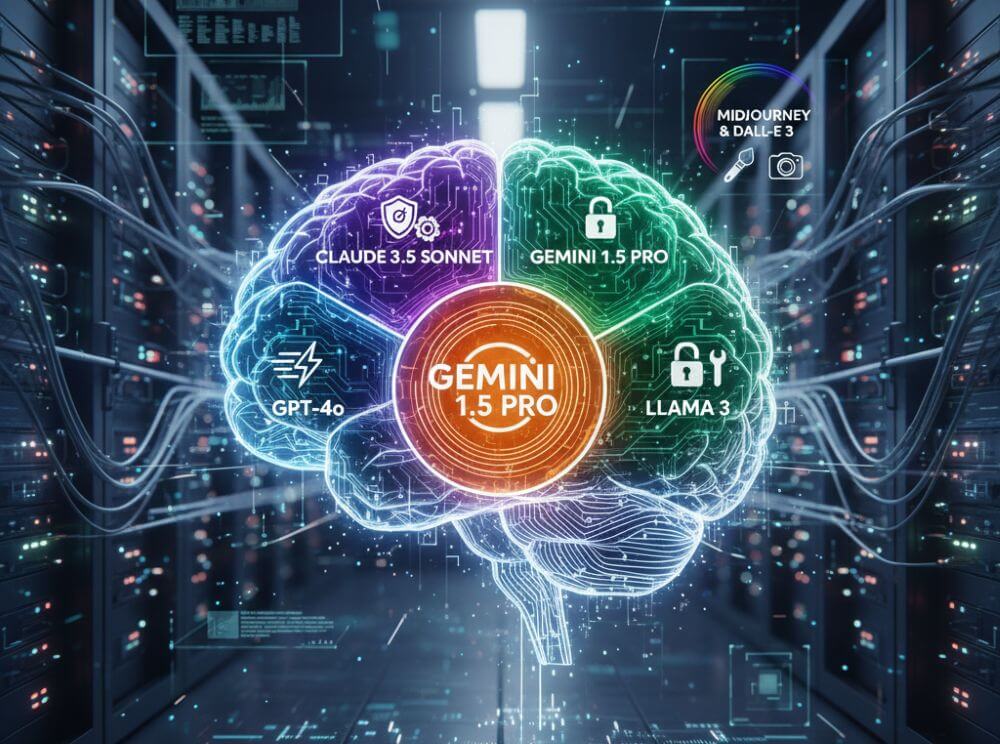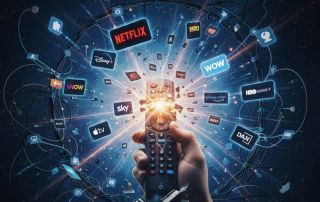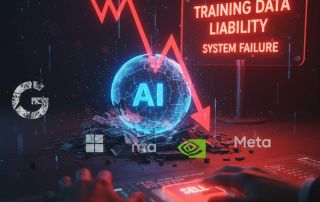The great AI showdown: Which model is right for you?
The artificial intelligence market is a jungle. New models and updates appear almost weekly, promising to eclipse everything that has come before. GPT, Claude, Gemini, Llama – who can keep track of it all?
Don’t worry. This article will shed some light on the subject. We’ll examine the most important AI models currently dominating the market, analyze their strengths and weaknesses, and answer the most crucial question: Which model best suits your needs?

The Titans: Closed Source Models
These are the heavyweights developed by large tech companies. They generally offer the highest performance and ease of use, but come with limitations in customization and cost.
1. OpenAI: The GPT Series (GPT-4o, GPT-4 Turbo)
OpenAI, backed by Microsoft, is the market leader. With ChatGPT, they made AI hype accessible to the masses.
The model: GPT-4o (“o” for Omni) is the current flagship. It’s a native multimodal model that can fluently process text, audio, and images in real time.
Advantages (Pros):
- Extremely powerful all-rounder: Very good at logical thinking, creative writing, and conversation.
- Speed: GPT-40 is significantly faster than its predecessor, GPT-4.
- Multimodality: The seamless integration of speech (natural-sounding conversation) and image recognition is market-leading.
- Ecosystem: Strong integration with many third-party tools and Microsoft products (Azure, Copilot).
Disadvantages (Cons):
- Costs: Using the API (Application Programming Interface) can become expensive with intensive use.
- “Black Box”: As a closed model, you have no control over the internal processes or training data.
Suitable for:
- Everyday users: Those who need a computer for everyday tasks after the Looking for the “best” chatbot (via ChatGPT Plus)?
- Developers: Those who need a robust and versatile API for their applications.
- Content creators: Those seeking inspiration and support for writing or brainstorming.
2. Anthropic: The Claude series (Claude 3.5 Sonnet, Claude 3)
- Founded by former OpenAI researchers, Anthropic places an extremely strong emphasis on security and ethics. They are OpenAI’s strongest competitor.
- The model: Claude 3.5 Sonnet recently made headlines by outperforming GPT-40 in many benchmarks (especially in programming and logical reasoning). The Claude 3 family also includes Opus (the most powerful) and Haiku (the fastest).
Advantages (Pros):
- Excellent logical reasoning: Often perceived as more precise and “intelligent” at complex tasks (law, science, coding).
- Security: Developed according to the “Constitutional AI” principle, resulting in more reliable and ethical answers (fewer “hallucinations” or strange outbursts).
- Long texts: Very strong at analyzing and summarizing long documents.
Cons:
- Multimodality: Image analysis is good, but (still) not as fluid and fast as GPT-40.
- Availability: Somewhat lower adoption and API integration than OpenAI.
Suitable for:
- Companies: Those that value data security and reliable, Ethical answers are needed.
- Programmers & Academics: Those who need a “workhorse” for complex logic problems or text analysis.
3. Google: The Gemini Series (Gemini 1.5 Pro & 1.5 Flash)
Google has consolidated its AI efforts with Gemini. Gemini’s key advantage lies in its enormous “context window.”
The model: Gemini 1.5 Pro is the main model. “Context window” refers to how much information the model can process at once. Gemini 1.5 Pro can process 1 million “tokens” by default—equivalent to an entire book or an hour of video.
Advantages (Pros):
- Huge context window: Unbeatable when analyzing very large documents (e.g., “Find clause X in this 500-page contract”) or entire code databases.
- Video analysis: Can analyze videos and answer questions about them.
- Google integration: Deeply embedded in the Google ecosystem (Google Search, Google Workspace, Android).
Cons:
- Creativity: Sometimes perceived as somewhat “dry” or less creative in its writing style than GPT or Claude.
- Fine-tuning: In some areas (e.g., coding), not quite at the level of Claude 3.5.
Suitable for:
- Data analysts & Researchers: Those who need to analyze huge amounts of data (text, code, video) all at once.
- Users of the Google ecosystem: Those who want to use AI directly in their emails, documents, and search queries.
The challengers: Open-source models
Open-source models can be downloaded, customized, and run on your own hardware (or in your own cloud) free of charge. This provides maximum control and data privacy.
4. Meta: Llama 3
Meta (Facebook) is a major driving force behind the open-source movement.
The Llama 3 model (available in sizes such as 8B, 70B, and soon 400B parameters) is currently the most powerful freely available model.
Advantages:
- Data Privacy & Control: Since it’s self-hosted, no data leaves your company.
- Adjustability (Fine-Tuning): Can be perfectly trained for very specific tasks (e.g., a chatbot with only medical expertise).
- Free: No license or API costs (apart from hardware costs).
Cons:
- Technical Effort: Requires powerful hardware (expensive GPUs) and technical expertise for operation and training.
- Security “Out of the Box”: The basic models are often less “censored” or secured than commercial products.
Suitable for:
- Startups & Enterprises: Use AI as the core of their application and require full control.
- Researchers & Hobbyists: Those who want to experiment with AI and build their own versions.
- Companies with strict data protection regulations: (e.g., banks, healthcare).
5. Mistral AI
The Paris-based startup Mistral has established itself as Europe’s AI champion.
The model: Mistral Large (commercial) and the Mixtral series (open source). Mixtral uses a “Mixture of Experts” (MoE) architecture.
Advantages (Pros):
- Efficiency: The MoE models are extremely fast and resource-efficient relative to their performance.
- Strong performance: Mistral models often outperform similarly sized Llama models.
- European focus: An advantage for companies that value EU compliance and data sovereignty.
Disadvantages (Cons):
- Smaller ecosystem: (Not yet) as widely supported as Llama or the “Big 3”.
Suitable for:
- European companies: Those seeking a powerful yet efficient alternative.
- Applications where speed (latency) is critical.
Specialists: The image generators
Text isn’t everything. When it comes to image creation, other names dominate:
Midjourney:
The undisputed king for artistic and photorealistic quality. The results are often breathtakingly stylized and “beautiful.” It’s primarily used via Discord.
DALL-E 3 (by OpenAI):
The best when it comes to text recognition. If you type “A red elephant sitting on a yellow bicycle reading a newspaper,” DALL-E 3 will render it most accurately. Perfectly integrated with ChatGPT.
Stable Diffusion (Open Source):
The Swiss Army knife of images. Open source, infinitely customizable (with “ControlNets” and “LoRAs”), but technically the most demanding. Used for very specific styles or tasks (e.g., product mockups).
Conclusion: Which AI model is right for whom?
There isn’t one best model. It depends on the task.
For everyday use & creative writing:
- GPT-4o (via ChatGPT) offers the most comprehensive and creative experience.
For programming & Complex logic:
-
- Claude 3.5 Sonnet often comes out on top here.
For analyzing huge documents or videos:
-
- Gemini 2.5 Pro is unbeatable thanks to its context window.
For companies with data protection needs:
- Llama 3.3 (self-hosted) offers maximum control.
For artistic Images:
Midjourney for the aesthetics, DALL-E 3 for the precise execution of instructions.
Beliebte Beiträge
Warum die Streaming-Zersplitterung nur einen Verlierer kennt
Die goldene Streaming-Ära ist vorbei. Netflix, Disney+, Sky & bald HBO Max zersplittern den Markt. Die Folge: Abo-Müdigkeit, steigende Kosten und Frust statt Komfort. Warum der Kunde der große Verlierer dieser Entwicklung ist.
Training Data Liability: Tech-Aktien im freien Fall
Der KI-Boom steht auf wackeligen Füßen. "Training Data Liability" (Haftung für Trainingsdaten) wird zum Top-Risiko. Urheberrechtsklagen & DSGVO-Strafen bedrohen die Geschäftsmodelle der Tech-Giganten. Warum der Markt jetzt panisch reagiert.
Vodafone earthquake at DE-CIX: The end of the open network?
A bombshell in the internet world: Vodafone is ending free public peering at DE-CIX. Data traffic will now be routed through its partner Inter.link – for a fee. What does this change in strategy mean for net neutrality and the quality of your stream?
Warning: The “Black Friday” trap in the office mailbox
Black Friday is full of dangerous traps lurking in office inboxes. Phishing emails disguised as great deals can lead to data theft and ransomware. Learn how to recognize these fraudulent emails immediately and effectively protect your business.
The worst-case scenario: How a massive data leak should shake us all up
A massive data breach is once again shaking the digital world. Millions of passwords and personal data are circulating – perhaps yours too. Our article shows you how to reliably check if you've been affected and what 5 steps you need to take immediately to prevent identity theft.
New Work & Moderne Karriere: Warum die Karriereleiter ausgedient hat
Die klassische Karriereleiter hat ausgedient. New Work fordert ein neues Denken: Skills statt Titel, Netzwerk statt Hierarchie. Erfahre, warum das "Karriere-Klettergerüst" deine neue Realität ist und wie du dich mit 4 konkreten Schritten zukunftssicher aufstellst.

































